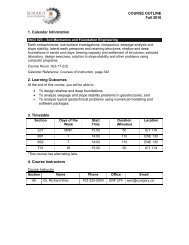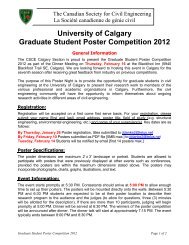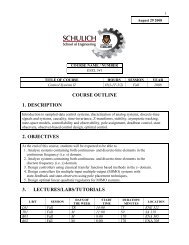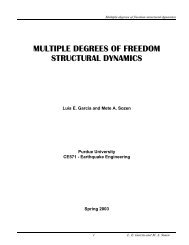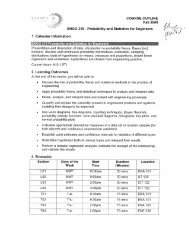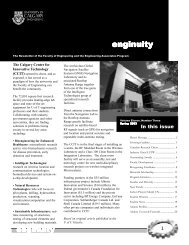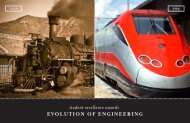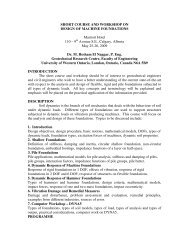The New NBCC - The Schulich School of Engineering
The New NBCC - The Schulich School of Engineering
The New NBCC - The Schulich School of Engineering
- No tags were found...
Create successful ePaper yourself
Turn your PDF publications into a flip-book with our unique Google optimized e-Paper software.
<strong>The</strong> new <strong>NBCC</strong>:Companion Loads,Wind/Snow Loadingand SeismicF. Michael BartlettF.CSCE, P. Eng.University <strong>of</strong>Western Ontari<strong>of</strong>.m.bartlett@uwo.ca
This Morning’s Agenda• Divisions A and B <strong>of</strong> <strong>NBCC</strong> 2005• Companion Action LoadCombinations• Importance Factors for Buildings• Changes to Specified Loads• Loose Ends• Summary
<strong>NBCC</strong> 2005 is Objective-basedDivision A (new!)• 4 objective categories• 46 functional statementsDivision B (familiar)• “Acceptable solutions”• transition mechanism
Code <strong>of</strong> HammurabiPhoto byC. R. Scollard
Wreckage1907
Finial asGraveMarker in St-RomualdCemetary17 Americans58 Canadians(33 CaughnawagaIron Workers)
Drop-in Span Collapse11 September 1916Death toll: 75 (1907) + 11 (1916) = 86
Canadian Code Milestones1922: CESA “Standard Specification forSteel Railway Bridges”1924: CESA “Standard Specification forSteel Structures for Buildings”1929: CESA “Standard Specification forConcrete and ReinforcedConcrete”1941: National Building Code <strong>of</strong> Canada
1974: Limit States DesignKey Players• D. J. L. Kennedy• J. G. MacGregor• D. E. AllenOthers• A. G. Davenport• N. C. Lind• D. A. Taylor
Safety Objectives in <strong>NBCC</strong> 05OS 1: Fire SafetyOS 2: Structural SafetyOS 3: Safety in UseOS 4: Resistance to Unwanted EntryOS 5: Safety at Construction andDemolition Sites
Structural Safety Objective“to limit the probability that aperson in or adjacent to thebuilding will be exposed to anunacceptable risk <strong>of</strong> injurydue to structural failure”
Structural Safety Sub-objectivesPrevent:• loads exceeding capacity <strong>of</strong> buildingelement or supporting medium• Damage/deterioration <strong>of</strong> elements• Vibration or deflection <strong>of</strong> elements• Instability <strong>of</strong> building or part <strong>of</strong> building• Collapse <strong>of</strong> excavations
Four Functional StatementsF20: To support and withstandexpected loads and forcesF21: To limit or accommodatedimensional changeF22: To limit movement underexpected loads and forcesF23: To maintain equipment in placeduring structural movement
Why this change?“Codes freeze technology”- Pr<strong>of</strong>. Paul Gavreau, U <strong>of</strong> TShortcoming <strong>of</strong> Division ADesigner must define, for a particularstructure constructed using particularmaterials, “unacceptable risk”.
Hence Division B “AcceptableSolutions”• Designs in conformance with theprescriptive requirements <strong>of</strong>Division B are deemed to havemet the Objectives <strong>of</strong> Division A.• Division B still represents “theminimum a designer is legallyallowed to get away with”.
Questions?
Moving along…• Divisions A and B <strong>of</strong> <strong>NBCC</strong> 2005• Companion Action Load Combinations– Rationale– Quantitative– Serviceability• Importance Factors for Buildings• Changes to Specified Loads• Loose Ends• Summary
<strong>NBCC</strong> 1995 FormatφR > α D D + ψ γ {α L L + α Q Q + α T T}where ψ = load combination factor• <strong>NBCC</strong> 1995 load combinations:1.25 D + 1.5 L1.25 D + 1.5 Q (wind)1.25 D + 0.7 {1.5 L + 1.5 Q (wind)}= 1.25 D + 1.05 L + 1.05 Q (wind)
Time History <strong>of</strong> LoadingLoadMaximum Load,for DesignTransientLive/WindSnowSustainedLiveRenovationDeadtime
Turkstra’s Rule (early ’80s)Worst case <strong>of</strong> combined transientloads occurs when:• one load, the principal action, is itsextreme value• other loads, the companion actions,are the largest that would beexpected while the principal actionhas its extreme value
Companion Action FormatφR > α D D + α i S i + Σ α ik S k , i ≠ kwhere S i = principal actionS k = companion actionsTypical Load Combinations:1.25 D + 1.5 L + 0.5 W (wind)1.25 D + 1.5 W (wind) + 0.5 L
Designer can Envisage Hazards• Correlation <strong>of</strong> transient loadsexplicitly considered• Can you imagine a structure wheresimultaneous maximum values <strong>of</strong>transient loads are:– unlikely?– expected?
Confederation Bridge: Wind + Live
Confederation Bridge: Wind + Ice
1995 <strong>NBCC</strong> Reliability Indices4Reliability index (50-year)321D + LD + WD + S00 1 2 3 4 5Nominal variable load/nominal dead load• reliability for snow load deficient?
2000/2001 Failures: Sarnia MallCollapseSource: Globe and Mail 09 December 2000
Snow Finds WeaknessesTop ChordEndDiagonalSupportBeam
Huge “Secondary” BendingActual load ~specified load
<strong>NBCC</strong> 2005 Calibration Process1. Reliability indices for 1995 <strong>NBCC</strong>2. Preliminary load combinations for 50-yr,500-yr loads by Bartlett, Hong & Zhou• review by Part 4 Task Group on Snow& Wind Loads• review by Part 4 Standing Committee3. Revised load combinations, 50-yr loads• review by Task Group and Part 4 cttee• public review
Calibration: Alberta FarmerWeighs Pig (MacGregor)Step 1:Put pig on plankStep 2:Add rocksuntil plank levelStep 3:Guess weight <strong>of</strong> rocks
2005 <strong>NBCC</strong> Combinations1.4 D1.25 D + 1.5 L + (0.4 W or 0.5 S)1.25 D + 1.4 W + (0.5 L or 0.5 S)1.25 D + 1.5 S + (0.5 L or 0.4 W)0.9 D + (1.5 L or 1.4 W or 1.5 S)Add to all combinations:P = prestressH = horizontal earth pressuresT = restrained deformations (safety)
Impact: Single Transient Load1.10Proposed/<strong>NBCC</strong> 19951.081.061.041.02D+SD+W1.000.98D+L0 1 2 3 4 5Transient-to-dead load ratio
Impact: D+L+S1.21.1Proposed/1995 <strong>NBCC</strong>1.00.90.8S/D = 0.250.51.02.04.00.70 1 2 3 4 5Live-to-dead load ratio, L/D
Impact: D+L+W1.2W/D = 4.01.1Proposed/1995 <strong>NBCC</strong>1.00.90.80.25 0.51.02.00.70 1 2 3 4 5Live-to-dead load ratio, L/D
Impact: D+W+S1.21.1Proposed/1995 <strong>NBCC</strong>1.00.90.250.51.02.0W/D = 4.00.80.70 1 2 3 4 5Snow-to-dead load ratio
Serviceability Limit States• Intention is not to greatly changeserviceability design criteria.• Consequence: specified snow loadincreases but for SLS check apply aSLS load factor <strong>of</strong> 0.9.• Simplification: eliminate 1-in-10 yrspecified wind load for SLS checkbut apply a SLS load factor <strong>of</strong> 0.75 tothe specified (1-in-50 yr) wind load.
Table A-4 in Commentary A:“Loads & Load Combinations for Serviceability”Limit States: Vibration serviceabilityOperation <strong>of</strong> moving equipmentDamage to non-structural comp.Damage to structural componentsGive:• Structural parameters to consider (stresses,accelerations, crack widths, deflections)• Loads + load combinations• References
Table A-5 in Commentary A“Load Combinations for Deflection Limit States”DifferentialSettlementLong TermDeflectionD + H + α L L+ α S SD + H + T P + P + α L L+ α S SShort Term (L + α S S) or (S + α L L)Deflectionor W or E
DrainageWaterrunsdownsurfaceWaterdripsawayfromsurface
Questions?• Far SideG. Larsen
Moving along…• Divisions A and B <strong>of</strong> <strong>NBCC</strong> 2005• Companion Action Load Combinations• Importance Factors for Buildings• Changes to Specified Loads• Loose Ends• Summary
Table 4.1.2.1 “ImportanceCategories for Buildings”Low: low direct or indirect hazard tohuman life.Normal: the kitchen-sink category.High: likely to be used as post-disastershelters or contain hazardoussubstances.Post-Disaster: essential to the provision<strong>of</strong> services after a disaster.
Importance Factors for S, WImportance Ultimate ServiceabilityCategory (Snow or Wind) Snow WindLow 0.8 0.9 0.75Normal 1.0High 1.15Post Disaster 1.25 0.9 0.75
Questions?
Moving along…• Divisions A and B <strong>of</strong> <strong>NBCC</strong> 2005• Companion Action Load Combinations• Importance Factors for Buildings• Changes to Specified Loads– Uncouple L from S– 50 year return periods for W, S• Loose Ends• Summary
Uncoupling Snow & Live• Logical consequence <strong>of</strong> consideringLive and Snow as independent.• Similar format adopted in ASCE-7based on load combinations derivedin 1980.• Consequence: Members resistinglow D, high L (use + occupancy),high S require less resistance.
Is there a structure down there?Clearing Trans Canada Highwayin <strong>New</strong>foundland(G. Jin, photo)
Live Loads on Ro<strong>of</strong>s• Table 4.1.5.3 specifies 1.0 kPa• Table 4.1.5.10 specifies 1.3 kNCommentary G “ Snow Loads”paragraph 51 states:“<strong>The</strong>se are use and occupancy loads,intended to provide for maintenanceloadings, workmen, and so forth.”“<strong>The</strong>y are not reduced as a function<strong>of</strong> area or ro<strong>of</strong> slope”
Return Period forEnvironmental Loads• <strong>NBCC</strong> 1995 specified:– 30 years for specified Snow, Wind– 10 years for Wind for deflections– 100 years for wind on ImportantStructures• Use 50 year or 500 year returnperiods (only) for 2005 <strong>NBCC</strong>?• Ratio n-yr/30-yr depends coefficient<strong>of</strong> variation <strong>of</strong> annual maximum load
Wind Speed DataCOV <strong>of</strong> Maximum Annual Wind Velocity0.400.300.200.100.00all data>10 yrs data0 20 40 60 80Longitude Difference (deg) from Alaska/Yukon Boundary
Specified Load Return Period2n-year pressure / 30-year pressure1.510.5mean90% <strong>of</strong> valuesin this range1-in-5001-in-1001-in-501-in-1000.00 0.05 0.10 0.15 0.20 0.25 0.30COV <strong>of</strong> Maximum Annual Wind Velocity
50-yr Wind & Snow Specified• typically ~10% greater than 30-yrvalues• snow load factor initially 1.7, impliesa 25% increase in factored load,deemed too big.• factored wind load unchanged,factored snow slightly greater• reduce for SLS checks
Questions?Far SideG. Larson
Moving along…• Divisions A and B <strong>of</strong> <strong>NBCC</strong> 2005• Companion Action Load Combinations• Importance Factors for Buildings• Changes to Specified Loads• Loose Ends– Dead load factors– Rain and ponding– Other examples• Summary
Proposed 1.2 D criticized• History: 1.3 proposed for 1975 <strong>NBCC</strong>.Reduced to 1.25 to maintain sameratio <strong>of</strong> dead/live load factor as in ACI318-71.• Proposed 1.2 D + 1.6 L not accepted• Specific concerns:– floor thickness variability– dead load <strong>of</strong> soil & landscaping– tributary area computation
2000 Survey:Concrete Floor Thickness• Marked variability for– Cast-in-place toppings on precast– Cover slabs in unshored compositeconstruction (tolerances?)• “Uncertain D” with load factor <strong>of</strong> 1.5not adopted• Make allowances for extra dead load• Consider deflections <strong>of</strong> supportingmembers
Tributary Areas in <strong>NBCC</strong>Commentary Fig F-1:0.55a0.5aa (typ)lines <strong>of</strong> zero shearhalfway betweencolumn lines• Safe for corners0.55b0.5b• Unsafe for 1 stinterior columns• Para 6: “For continuous construction,structural analysis is required to find the lines <strong>of</strong>zero shear.”
Rain Loads and Ponding• Flat ro<strong>of</strong>s deflect, intensifying load inworst place• Essential design consideration forCalgary and southern Alberta• <strong>NBCC</strong> Commentary H gives guidance– One-day rain load?– Residual stresses?– Multiple-span cases?• Western M.E.Sc. thesis by Praught
Regions where 1-day rain exceedssnow load on flat ro<strong>of</strong>Calgary(103%)Port Hardy(131%)T<strong>of</strong>ino(147%)Ucluelet(132%)Leamington (107%)
1-d rain and 24-hr rain• 1-d rain recorded 12:00 to 12:00• 24-hr rain in any 24-hr periodRainIntensity24-hr captures whole storm1-day rain does notTime• 24-hr rain/1-d rain ~ 1.23
WhitehorseRegions where 24-hour rainexceeds snow loadIqaluitYellowknifePort HardyEdmontonStUcluelet/TolfinoVancouverVictoriaCalgaryReginaWinnipegQuebecCharlottetownFrederictonHalifaxMontrealOttawaTorontoLeamington• Similar to Nixon’s (1979) “Ponding Map <strong>of</strong>Canada”
<strong>NBCC</strong> ignores residual stressesInitialEIMomentSecantEI atgiven MCurvatureUnderestimates ponding deflections
Animation by Schouten<strong>Engineering</strong> Consultants, NL
Stepwise Analysis1. Load joists2. Calculate joist deflections, reactions3. Apply reactions to beams4. Calculate beam moments, deflections5. Calculate total deflected shape6. Do deflections converge?NO: recompute load and repeat analysisYES: stop, check capacities not exceeded
Gerber Beam Example Calculation• Joists at 1.5m span 10.5m betweenbeams• W530x66 cantilever/anchor beam• W460x52 drop-in beam• Design for Calgary snow load, checkfor 1-day (not 24-hr, not factored) rain
Deflected shape after 1 st iterationJoistDeflectionBeam Deflection
Beam Moments+26%Final (after 6 th iteration)InitialC sym L-20%Volume <strong>of</strong> water on drop-in & cantileverspans reduces 46%-26%
DeflectionsC LsymInitialFinal
Questions?
David’s Questions1. Composite prestressed concretemembers will have stress limitsbased on dead, live andenvironmental loads. In the past Ihave used working stress loadcombinations to verify the stresses.How is this handled now?
More Questions!2. Why use different load factors forwind loads than for occupancyloads? This does not follow theISO standards recommendationsand does not follow the trend beingfollowed in Europe (EuroCode 1990)and the US (ASCE-7-02 LRFD).
More Questions!3. In the US, ASCE-7-05 uses a returnperiod <strong>of</strong> 50 years but the C b set at0.70 versus 0.80 in the NationalBuilding Code <strong>of</strong> Canada. Why arewe increasing the snow loadrelative to the US?
A Loaded Question?4. What loads are temporarystructures to be designed for in thenew building code? Are thestructures to be designed for thesame likelihood <strong>of</strong> failure in anannual period or are they to bedesigned for the same likelihood <strong>of</strong>failure over the service life <strong>of</strong> thestructure?
Questions?
Summary1. Companion action loadcombination format proposed for<strong>NBCC</strong> 2005:• more realistic representation• permits logical decisions for unusualcases• little difference for many members• consistent with other internationalstandards (ACI 318, AISC LRFD, etc.)
2. Dead loads:• make allowance for extra thickness <strong>of</strong>thin toppings• tributary areas for first interiorcolumns3. Snow loads are no longer classifiedwith live loads due to use andoccupancy.• less resistance needed for memberscarrying snow and live loads
4. Only 50-year environmental loadsspecified:• increases specified loads by ~ 10%• additional increases for important andpost-disaster buildings• load factors less than 1.0 reducespecified loads for serviceabilitychecks.5. <strong>New</strong> load combinations give similardemands to <strong>NBCC</strong> 1995:• less demand due to snow & live loads• more demand due to snow only
6. Watch out for ponding <strong>of</strong> rainwateron flat ro<strong>of</strong>s:• 24-hr rain ~1.23 x 1-day rain• residual stresses reduce stiffness• multi-span members can sharewater between spans7. <strong>The</strong> National Building Code remainsa minimum standard:• consult with owner to confirmwhat really is necessary
“More than ever before,the challenge to thepr<strong>of</strong>ession is todevelop designers whohave sufficient intuitionto stand up to, andreject or modify, theresults <strong>of</strong> a computeraidedanalysis ordesign.”--- J. G. MacGregor,Pr<strong>of</strong>essor Emeritus, University <strong>of</strong> Alberta
Additional References• Two papers by Bartlett, Hong &Zhou, Canadian Journal <strong>of</strong> Civil<strong>Engineering</strong>, April 2003.• Paper by Praught & Bartlett in 2005CSCE Annual Conference, Toronto.• More information:f.m.bartlett@uwo.ca
Acknowledgements• National Research Council <strong>of</strong> Canada• National Sciences & <strong>Engineering</strong>Research Council <strong>of</strong> Canada• NBC Part 4 Task Group on Snow andWind Loads (D. E. Allen, Chair)• Canadian Meteorological Centre• Steel Structures EducationFoundation• J. G. MacGregor



